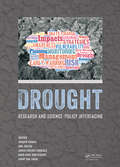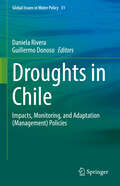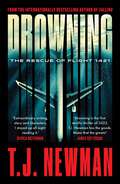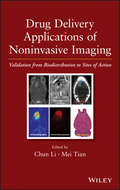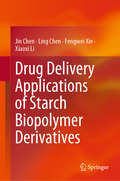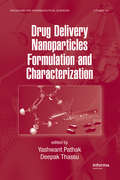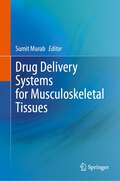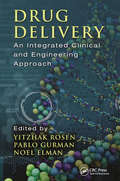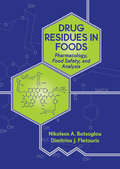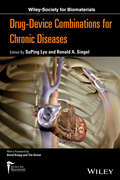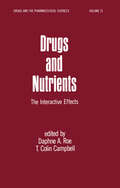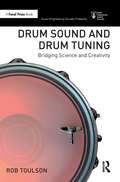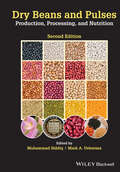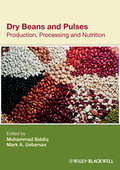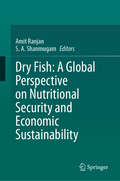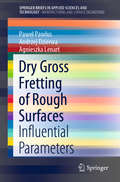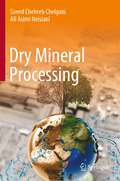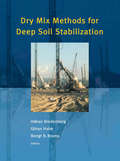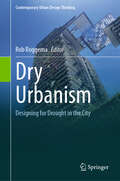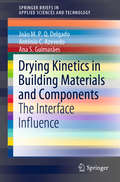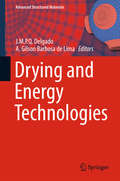- Table View
- List View
Drought: Research and Science-Policy Interfacing
by Pedro Pacheco Filipe MagalhãesDroughts occur in arid and semi-arid areas of the world, but also in humid areas, and can develop over short periods (flash drought) or longer periods (seasons/decades). Even though progress has been made, it remains difficult to adequately characterize, monitor, forecast and manage droughts, due to their multi-faceted nature.Usually, drought does
Droughts in Chile: Impacts, Monitoring, and Adaptation (Management) Policies (Global Issues in Water Policy #31)
by Guillermo Donoso Daniela RiveraThe case of Chile is illustrative of a transition from command and control to market-based management policies, where economic incentives play a significant role in water management. This book deals with drought policy in Chile and other countries. It offers a detailed examination of drought management and policies. It describes, analyzes and evaluates the performance of drought policies, laws and institutions, identifies the main challenges that Chile faces and derives lessons learnt. Expert contributors discuss such topics as Chile’s drought water policy, and the reasoning which explains present challenges.
Drowning: the most thrilling blockbuster of the year
by T. J. NewmanFlight attendant turned New York Times bestselling author T. J. Newman - whose first book Falling was an instant international bestseller and the biggest thriller debut of 2021 - returns for her second book, an edge-of-your-seat thriller about a commercial jetliner that crashes into the ocean, and sinks to the bottom with passengers trapped inside, and the extraordinary rescue operation to save them.Six minutes after takeoff, Flight 1421 crashes into the Pacific Ocean. During the evacuation, an engine explodes and the plane is flooded. Those still alive are forced to close the doors—but it&’s too late. The plane sinks to the bottom with twelve passengers trapped inside. More than two hundred feet below the surface, engineer Will Kent and his eleven-year-old daughter Shannon are waist-deep in water and fighting for their lives. Their only chance at survival is an elite rescue team on the surface led by professional diver Chris Kent - Shannon&’s mother and Will&’s soon-to-be ex-wife - who must work together with Will to find a way to save their daughter and rescue the passengers from the sealed airplane, which is now teetering on the edge of an undersea cliff.There&’s not much time. There&’s even less air.With devastating emotional power and heart-stopping suspense, Drowning is an unforgettable thriller about a family&’s desperate fight to save themselves and the people trapped with them - against impossible odds.Praise for Drowning: 'Stunning, emotional, and unforgettable. Drowning reads like Apollo 13 underwater' Don Winslow, New York Times bestselling author of City on Fire and The Border 'Drowning is The Poseidon Adventure meets The Martian. It is another can&’t-put-down, edge-of-your-seat thriller from T. J. Newman, one of our most exciting new authors' Adrian McKinty, New York Times bestselling author of The Chain and The Island 'Drowning is pure adrenaline and all heart. Gripping, relentless, effortlessly assured, T. J. Newman&’s thriller is tense and moving. You&’ll be grabbed from page one as the crew and passengers of a downed airliner fight for survival and rescuers race to reach them. Drowning is an incredible ride - strap in, brace, and remember to breathe' Meg Gardiner, #1 New York Times bestselling author
Drug Delivery Applications of Noninvasive Imaging
by Mei Tian Chun LiCost-effective strategies for designing novel drug delivery systems that target a broad range of disease conditionsIn vivo imaging has become an important tool for the development of new drug delivery systems, shedding new light on the pharmacokinetics, biodistribution, bioavailability, local concentration, and clearance of drug substances for the treatment of human disease, most notably cancer. Written by a team of international experts, this book examines the use of quantitative imaging techniques in designing and evaluating novel drug delivery systems and applications.Drug Delivery Applications of Noninvasive Imaging offers a full arsenal of tested and proven methods, practices and guidance, enabling readers to overcome the many challenges in creating successful new drug delivery systems. The book begins with an introduction to molecular imaging. Next, it covers:In vivo imaging techniques and quantitative analysisImaging drugs and drug carriers at the site of action, including low-molecular weight radiopharmaceuticals, peptides and proteins, siRNA, cells, and nanoparticlesApplications of imaging techniques in administration routes other than intravenous injection, such as pulmonary and oral deliveryTranslational research leading to clinical applicationsImaging drug delivery in large animal modelsClinical applications of imaging techniques to guide drug development and drug deliveryChapters are based on a thorough review of the current literature as well as the authors' firsthand experience working with imaging techniques for the development of novel drug delivery systems.Presenting state-of-the-technology applications of imaging in preclinical and clinical evaluation of drug delivery systems, Drug Delivery Applications of Noninvasive Imaging offers cost-effective strategies to pharmaceutical researchers and students for developing drug delivery systems that accurately target a broad range of disease conditions.
Drug Delivery Applications of Starch Biopolymer Derivatives (SpringerBriefs in Molecular Science)
by Jin Chen Xiaoxi Li Ling Chen Fengwei XieThis book summarizes the recent advances in applications of starch in state-of-the-art drug carriers (hydrogel, micro- and nano-particulate carriers) with stimulus-responsive and target-specific properties. It also highlights the role of starch and its derivatives in transmucosal administration to improve the bioavailability of drugs. Further, it outlines the principles of effective, advanced, starch-based drug delivery systems and illustrates how these principles are key to the development of future drug delivery strategies. This interesting reference resource is useful for students, researchers and engineers in the fields of carbohydrate chemistry, polymer sciences and drug delivery.
Drug Delivery Nanoparticles Formulation and Characterization (Drugs and the Pharmaceutical Sciences)
by Yashwant Pathak Deepak ThassuExploring fundamental concepts, Drug Delivery Nanoparticles Formulation and Characterization presents key aspects of nanoparticulate system development for various therapeutic applications and provides advanced methods used to file for regulatory approval.This comprehensive guide features:Process Analytical Techniques (PAT) used in manufacturing Na
Drug Delivery Systems for Musculoskeletal Tissues
by Sumit MurabMusculoskeletal tissues are hard to heal if damaged by disease or trauma. If damaged, they cause pain and hinder regular movements of our bodies. Drug delivery systems that can be used for healing and regenerating these tissues need to be specialized to bear physiological loading on these tissues while helping in controlled release of drug or biomolecules for healing the tissue. This book discusses the pathology of orthopaedic diseases and the requirements of local drug delivery platforms that can help in the treatment of the pathology as well as regeneration of the tissue. The book also discusses in detail the mechanical properties and support that these systems provide to the damaged musculoskeletal tissues and how long-term healing and regeneration is possible. This is an ideal book for students, postdoctoral fellows and faculty at academic universities, and industry professionals who are working on drug delivery, orthopaedic diseases, tissue engineering, and regenerative medicine.
Drug Delivery Systems: Advanced Technologies Potentially Applicable in Personalised Treatment
by Jorge CoelhoThis book is part of a series dedicated to recent advances on preventive, predictive and personalised medicine (PPPM). It focuses on the theme of "Drug delivery systems: advanced technologies potentially applicable in personalised treatments". The critical topics involving the development and preparation of effective drug delivery systems, such as: polymers available, self-assembly, nanotechnology, pharmaceutical formulations, three dimensional structures, molecular modeling, tailor-made solutions and technological tendencies, are carefully discussed. The understanding of these areas constitutes a paramount route to establish personalised and effective solutions for specific diseases and individuals.
Drug Delivery Using Nanomaterials (Emerging Materials and Technologies)
by Yasser ShahzadAfter the drug discovery and development process, designing suitable formulations to safely deliver the optimum dose, while avoiding side effects, has been a constant challenge, especially when drugs are very toxic and have poor solubility and undesirable clearance profiles. With recent advances in synthetic technologies, nanoparticles can be custom-made from a variety of advanced materials to mimic the bioenvironment and can be equipped with various targeting and imaging moieties for site-specific delivery and real-time imaging. Drug Delivery Using Nanomaterials covers advancements in the field of nanoparticle-based drug-delivery systems, along with all the aspects needed for a successful and marketable nanoformulation. FEATURES Offers a general overview of the entire process involved in the synthesis and characterization of pharmaceutical nanoparticles Covers a broad range of synthetic materials for developing nanoformulations customized for specific disease states, target organs, and drugs Every chapter sequentially builds, providing a progressive pathway from classical nanoparticles to the more advanced to be used as a full drug product by consumers Provides information in a bottom-up manner in that definitions and explanations of relevant background information serve as a framework for understanding advanced concepts This user-friendly reference is aimed at materials engineers, chemical engineers, biomedical engineers, pharmaceutical scientists, chemists, and others working on advanced drug delivery, from academia as well as industry.
Drug Delivery: An Integrated Clinical and Engineering Approach
by Yitzhak Rosen Pablo Gurman Noel ElmanIntegrating the clinical and engineering aspects of drug delivery, this book offers a much needed comprehensive overview and patient-oriented approach for enhanced drug delivery optimization and advancement. Starting with an introduction to the subject and pharmacokinetics, it explores advances for such topics as oral, gastroretentive, intravitreal, and intrathecal drug delivery, as well as insulin delivery, gene delivery, and biomaterials-based delivery systems. It also describes drug delivery in cancer, cardiac, infectious diseases, airway diseases, and obstetrics and gynecology applications. Examining special clinical states requiring innovative drug delivery modifications, such as hypercoagulability often seen in pregnancy, cancer, and autoimmune diseases, the book also discusses methods for improved drug delivery in clinical settings using clinical end points, clinical trials, simulations, and other venues. It also describes the latest drug delivery advances involving nanomaterials, NEMS and MEMS devices, hydrogels, microencapsulation, lipids, stem cells, patches, and ultrasound. The book is rounded out by a chapter on the FDA regulatory and bioethical challenges involved in advancing drug delivery.
Drug Residues in Foods: Pharmacology: Food Safety, and Analysis
by Nikolaos A. Botsoglou Dimitrios J. Fletouris"Offers unique data on the physiochemical properties, functions and metabolism, toxicological and pharmacological effects, regulatory control, antimicrobial resistance, and consumer perceptions of food residue regulation."
Drug of Choice: A Novel
by Michael Crichton John LangeTo uncover the secrets of a superdrug, a doctor must go undercover and risk it all . . .When a Hell's Angel is thrown from his bike at 110 miles per hour, he should probably end up in the morgue. But this Angel survives his crash without a scratch, and ends up sleeping peacefully in the hospital. When Dr. Roger Clark inspects him, he finds only one defect: blue urine. Similar reports start to trickle in from hospitals upstate. It seems that a strange new drug is sending people into comas, and only Clark can unravel its mystery.His search for answers takes him on the strangest trip of his life, into a place called "Eden," which looks like paradise, but feels like hell.This ebook features an illustrated biography of Michael Crichton including rare images from the author's estate.
Drug-device Combinations for Chronic Diseases (Wiley-Society for Biomaterials)
by Ronald Siegel SuPing LyuThis book covers two areas, the first detailing the concepts and technologies of drug-device combination products. The second area includes case studies of important products that either significantly shape our technologies and thinking, or contribute to current healthcare practice. The book: Discusses where drugs and devices work, where they fail, and when they need to work with each other Reviews interactions between human bodies and the drug-device combination products the measurements of these interactions Covers how a drug-device combination product is developed, tested, and regulated Includes case studies of steroid releasing leads, AOA treated tissue heart valves, intrathecal drug delivery pumps, infuse bone grafts, drug eluting stents, and antimicrobial meshes
Drugs and Nutrients: The Interactive Effects
by D. A. RoeThis book is devoted to the effects of food and of nutrient intake on the disposition of foreign compounds, and discusses effects of drugs on nutrition. It is intended for nutritionists and clinical investigators concerned with interpretation of aberrant effects of therapeutic drugs.
Drum Sound and Drum Tuning: Bridging Science and Creativity (Audio Engineering Society Presents)
by Rob ToulsonDrum Sound and Drum Tuning assists drummers, sound engineers, and music students in learning critical skills related to drum sound and achieving an optimised and personalised drum kit set-up. The book covers the essential theories of percussion acoustics and develops this knowledge in order to facilitate creative approaches to drum tuning and professional-level recording and mixing of drums. All aspects of drumhead vibration, drumhead equalisation, and resonant drumhead coupling are de-mystified, alongside discussions relating to drumhead types, drum shell vibration, and tuning to musical intervals for different performance genres. The book develops drum sound theory and creative analysis into a detailed dissection of recording and production techniques specifically for drums, including discussions on studio technologies, room acoustics, microphone techniques, phase coherence, and mixing drums with advanced digital audio workstation (DAW) techniques and creative processing tools. Drum Sound and Drum Tuning includes many practical hands-on exercises that incorporate example tutorials with Logic Pro and iDrumTune Pro software, encouraging the reader to put theory into immediate creative practice and to develop their own listening skills in an informed and reflective manner. The book also documents primary interviews and opinion from some of the world’s most celebrated drummers, music producers, and sound engineers, enabling the reader to connect the relevant theories with real-world context, whilst refining their own personalised approach to mastering drum sound.
Dry Beans and Pulses Production, Processing, and Nutrition: Production, Processing And Nutrition
by Muhammad Siddiq Mark A. UebersaxDry Beans and Pulses The second edition of the most complete and authoritative reference on dry beans production, processing, and nutrition available Since the first edition of Dry Beans and Pulses: Production, Processing, and Nutrition was published in 2012, the popularity of pulse crops as sustainable, nutritionally-rich food ingredients for alternate meat and other food products has increased significantly beyond traditional utilization. Retaining its distinctive value-chain approach to the subject, the new edition is fully revised to provide up-to-date coverage of breeding, composition, quality, nutritional profiles, postharvest and processing technologies, food safety and security, significance to human health, and more. A team of more than fifty contributors review recent research, consumer trends, new products, and food security issues in dry beans processing and value-added practices. New chapters address Hard-to-cook phenomenon and other storage-induced quality defects, quality assessment of raw and processed legumes using innovative technologies, utilization of dry beans and pulses as ingredients in diverse food products, and the production, processing, and nutritional profile of Faba beans and chickpeas and lentils. Covering both traditional and non-traditional bean classes, this comprehensive volume: Features new topics, expanded discussion, updated references, and additional figures and tables throughout Provides in-depth information on key aspects of production technologies, value-added processing, and Culinology® Examines global production and consumption, packaging and distribution, and nutrient bioavailability of bioactive compounds Highlights worldwide efforts to improve the quality and utilization of dry beans and pulses Discusses emerging trends and new applications of antioxidant properties of dry beans as functional foods Features chapters written by experts in disciplines such as crop science, horticulture, food science and technology, food biochemistry and engineering, and nutritional and environmental sciences Dry Beans and Pulses: Production, Processing, and Nutrition, Second Edition remains required reading for food scientists, nutritionists, agronomists, researchers, food processing specialists, and food security experts, food engineers and chemists involved in dry beans processing and value-added technologies.
Dry Beans and Pulses: Production, Processing and Nutrition
by Muhammad Siddiq Mark A. UebersaxThe common beans and pulses are diverse food resources of high nutritional value (protein, energy, fiber and vitamins and minerals) with broad social acceptance. These legume crops demonstrate global adaptability, genotypic and phenotypic diversity, and multiple means of preparation and dietary use. Beans and pulses are produced in regions as diverse as Latin America, Africa, Asia, and North America, and on a scale similar to some other crops, such as wheat, corn, rice and soybeans. Numerous factors influence utilization, including bean type and cultivar selection, cropping environment and systems, storage conditions and handling infrastructure, processing and final product preparation. Nutrient content and bio-availability are dramatically influenced by these conditions. In recent years, beans and pulses have been cited for imparting specific positive health potentiating responses, such as hypocholesteremic response, mitigation of diabetes and colonic cancer, and weight control. Enhanced dry bean utilization focused on improved dietary health is an opportunity within both subsistent and developed populations. This book provides a contemporary source of information that brings together current knowledge and practices in the value chain of beans/pulses production, processing, and nutrition. It provides in-depth coverage of a wide variety of pertinent topics including: breeding, postharvest technologies, composition, processing technologies, food safety, quality, nutrition, and significance in human health. An experienced team of over 25 contributors from North America, Asia, and Africa has written 15 chapters, divided into three sections: Overview, production and postharvest technologies of beans and pulses Composition, value-added processing and quality Culinology, nutrition, and significance in human health Contributors come from a field of diverse disciplines, including crop sciences, food science and technology, food biochemistry, food engineering, nutritional sciences, and culinology. Dry Beans and Pulses Production, Processing and Nutrition is an essential resource for scientists, processors and nutritionists, whatever the work setting.
Dry Etching Technology for Semiconductors
by Kazuo NojiriThis book is a must-have reference to dry etching technology for semiconductors, which will enable engineers to develop new etching processes for further miniaturization and integration of semiconductor integrated circuits. The author describes the device manufacturing flow, and explains in which part of the flow dry etching is actually used. The content is designed as a practical guide for engineers working at chip makers, equipment suppliers and materials suppliers, and university students studying plasma, focusing on the topics they need most, such as detailed etching processes for each material (Si, SiO2, Metal etc) used in semiconductor devices, etching equipment used in manufacturing fabs, explanation of why a particular plasma source and gas chemistry are used for the etching of each material, and how to develop etching processes. The latest, key technologies are also described, such as 3D IC Etching, Dual Damascene Etching, Low-k Etching, Hi-k/Metal Gate Etching, FinFET Etching, Double Patterning etc.
Dry Fish: A Global Perspective on Nutritional Security and Economic Sustainability
by Amit Ranjan S. A. ShanmugamDry fish is an excellent and cheap source of protein and fat in both developed and developing nations, especially for vulnerable populations. Its nutritional value, cultural importance, and economic relevance make it an integral part of diets and food systems worldwide. The diverse culinary applications and international trade of dry fish further highlight its relevance and appeal on a global scale. It offers distinct taste and flavors, adding diversity to global cuisines and enhancing culinary experiences. It is used in various recipes, from stews and curries to snacks and condiments and is highly valued for its long shelf life and nutritional benefits. Consumption of dry fish not only improves nutrition but also has far-reaching impacts on the economy, society and cultural practices. It meets the dietary requirements of marginalized communities and contributes to food security. In coastal regions, salted and sun-dried fish are widely consumed, reflecting the importance of this preservation method. Dry fish plays a crucial role in nutritional security, particularly in coastal areas, where it holds immense importance for the economy, society, and culture. Dry fish also serves as a valuable commodity in international markets, fostering cross-cultural exchanges and contributing to trade flows. Furthermore, dry fish has gained popularity in various global cuisines. Countries like Portugal, Spain, Thailand and several African nations have their own versions of dried or salted fish dishes, reflecting the diverse culinary traditions and preferences around the world. Dry Fish: A Global Perspective on Nutritional Security and Economic Sustainability offers a global perspective on the sustainability of dry fish production and its environmental implications. It explores traditional and advanced drying methods, their impact on fish stocks and potential strategies for sustainable practices. The text discusses the challenges and opportunitiesin the industry, such as market trends, consumer preferences and technological advancements. The book combines scientific research, case studies and expert insights to provide a comprehensive overview of the topic. It serves as a valuable resource for researchers, policymakers and professionals in the fields of nutrition, food security, fisheries and economic development. By highlighting the importance of dry fish as a global resource, the book aims to foster discussions and actions that promote the sustainable utilization of this valuable food source for the benefit of present and future generations.
Dry Gross Fretting of Rough Surfaces: Influential Parameters (SpringerBriefs in Applied Sciences and Technology)
by Pawel Pawlus Andrzej Dzierwa Agnieszka LenartIn this book, the authors present a comprehensive study of the effects of operating parameters (load, amplitude, frequency) on dry gross fretting of rough surfaces. It helps the reader to efficient surface preparations in order to monitor and reduce damage caused by fretting. It exposes the effect of surface topography on fretting, which is often neglected.
Dry Mineral Processing
by Saeed Chehreh Chelgani Ali Asimi NeisianiThis book introduces and explains all existing dry processing methods, drawing from larges studies about these techniques in both the academia and industrial sectors. Potentially, water insufficiency is one of the critical issues that could be the major cause of international conflicts. Thus, reducing water consumption and pollution in all industrial sectors is an essential issue for all countries. As a main part of the mining industry, ore processing plants are highly dependent on water, and water scarcity poses significant risk to the industry. Thus, water consumption is a strategic issue for mineral processing plants, particularly in dry climate countries. To select dry or wet processing, the differences between these conditions should be taken into consideration, which needs an in-depth understanding of the various possible methods. This book will be of interest to professionals and researchers.
Dry Mix Methods for Deep Soil Stabilization
by Håkan Bredenberg Göran Holm Bengt B. BromsIt is a truism that we can no longer freely pick areas with the most suitable ground conditions for building purposes. Soils must often be improved in order to take the loads from buildings, roads and other objects. This volume contains papers covering a range of relevant topics and issues.
Dry Urbanism: Designing for Drought in the City (Contemporary Urban Design Thinking)
by Rob RoggemaThe ambition of the book is to give a contemporary insight in the state of the art when it comes to designing our cities and landscapes for dry conditions. Water, or the absence thereof, is an important issue to consider. Many cities around the world are increasingly suffering heat, droughts and occasional severe flooding and rainfall. This asks for new approaches, and methodologies to (re)design the urban and rural condition to stay livable. This book aims to connect theories (the methodologies and approaches) with practice (concrete examples and projects).
Drying Kinetics in Building Materials and Components: The Interface Influence (SpringerBriefs in Applied Sciences and Technology)
by Ana S. Guimarães António C. Azevedo João M. DelgadoThis work presents an extensive experimental characterisation of two different ceramic brick blocks with different interface, at different heights, during the drying process. First, a laboratory characterization of the building material used (ceramic bricks and different mortars) is presented, showing their hygrothermal, mechanical and thermal properties, namely, bulk porosity and density, water vapour permeability, capillary absorption, retention curve, moisture diffusivity as a function of moisture content and thermal conductivity. Moreover, the moisture transfer in multi-layered systems was analysed in detail taking into account the interface contact between the building elements.
Drying and Energy Technologies
by J.M.P.Q. Delgado A. Gilson Barbosa de LimaThis book provides a comprehensive overview of essential topics related to conventional and advanced drying and energy technologies, especially motivated by increased industry and academic interest. The main topics discussed are: theory and applications of drying, emerging topics in drying technology, innovations and trends in drying, thermo-hydro-chemical-mechanical behaviors of porous materials in drying, and drying equipment and energy. Since the topics covered are inter-and multi-disciplinary, the book offers an excellent source of information for engineers, energy specialists, scientists, researchers, graduate students, and leaders of industrial companies. This book is divided into several chapters focusing on the engineering, science and technology applied in essential industrial processes used for raw materials and products.
